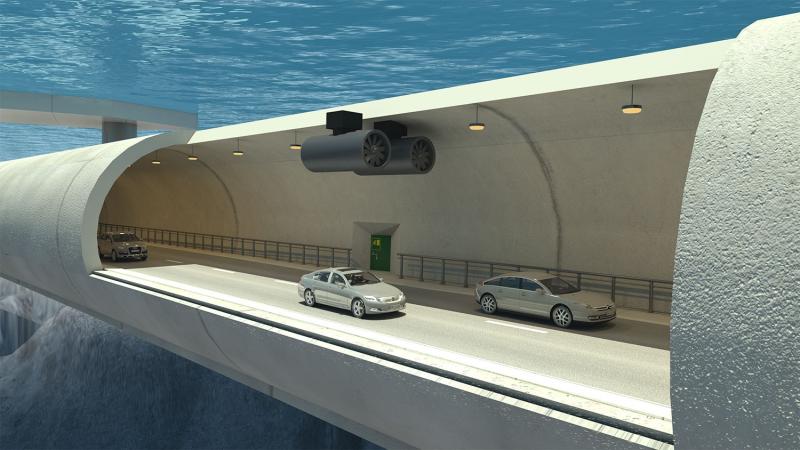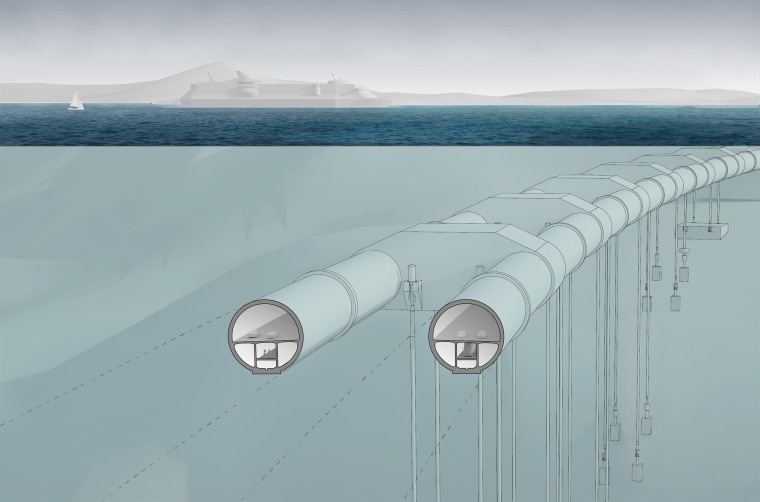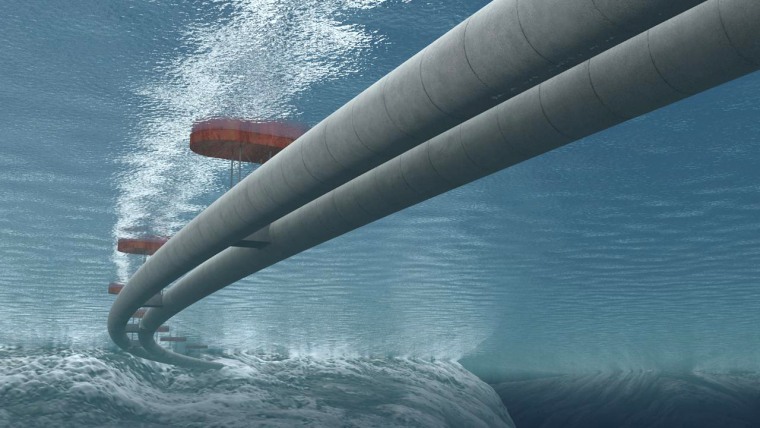World's first 'floating tunnel' proposed in Norway



Steep, icy mountains and deep fjords make western Norway famously scenic, but they also make life difficult for motorists. With seven ferries along the way, the almost 700-mile trip between the cities of Kristiansand in the south and Trondheim in the north typically runs about 21 hours — at an average speed of about 30 miles an hour.
But that could soon change. A $40-billion infrastructure project being planned by the Norwegian government aims to replace the ferries with bridges, conventional tunnels and what could be the world’s first “floating tunnel.”
The submerged roadway — essentially a pair of concrete tubes submerged about 100 feet below the water’s surface — would help cut the Kristiansand-Trondheim travel time almost in half while minimizing the environmental impact on the area.
 The tunnel would be made up of a pair of concrete tubes submerged about 100 feet under the water’s surface. Sn?hetta
The tunnel would be made up of a pair of concrete tubes submerged about 100 feet under the water’s surface. Sn?hetta Experts say the floating tunnel concept is especially suited for deep fjords surrounded by steep mountains — features that make it difficult to build bridges or drill tunnels.
“With bridges that span long distances, you need arches and suspensions at certain points, but for a submerged floating tunnel, if you do it absolutely correct and balance the weight of the structure with the buoyancy of the structure, it can go on forever,” said Nils Erik Anders Rønnquist, a professor of structural engineering at the Norwegian University of Science and Technology, who is consulting on the project for the government.
Though the floating tunnel is buoyant, it isn’t actually floating. The tubes would be stabilized by cables tethered to the seabed or by pontoons floating on the surface at roughly 800-foot intervals. With most of the hardware far below the surface, the tunnel wouldn’t interfere with the movement of ships and boats and even submarines, said Arianna Minoretti, chief engineer for the Norwegian Public Roads Administration.
 The tunnel would be stabilized by cables tethered to the seabed or by pontoons floating on the surface. Norwegian Public Roads Administration / Vianova
The tunnel would be stabilized by cables tethered to the seabed or by pontoons floating on the surface. Norwegian Public Roads Administration / Vianova Like conventional tunnels, the floating tunnel would have escape routes that motorists could take to return to the surface in case of an emergency. And Minoretti said preliminary research regarding the proposed tunnel’s safety has been reassuring.
“We have done simulations for big explosions in the tunnel, we’ve checked for impacts of submarines, we covered scenarios where a trawler might hook onto the tunnel, and we even considered if a ship might be sinking at the surface and hit the tunnel on the way down,” Rønnquist said. “I would say things are under control. It’s a very robust structure.”
But Michael Mooney, a civil and environmental engineer at the Colorado School of Mines, said the trickiest part of designing and building a first-of-its-kind large structure would be anticipating all the possible hiccups.
“You want to make sure you think of all the potential load scenarios or things like wave motion,” said Mooney, who isn’t involved with the Norwegian project. “The big challenge is recognizing where all the issues are and not being surprised by something.”
Kevin Chang, a civil and environmental engineer at the University of Idaho, offered a similar assessment of the challenges involved in building such a tunnel. “At the end of the day, the engineering community tends to be on the conservative side,” he said. “But with novel ideas, somebody has to sort of stick their neck out to say: We think this is the best solution even though it’s unproven elsewhere.”
Plans call for the floating tunnel to open to traffic in 2050. And while it might be the first structure of its kind, it might not be the last. Rønnquist said engineers in Italy and China are pursuing similar concepts.



Uber cool~ Just think about how this could be applied.
San Francisco has had an underwater tunnel that spans the bay for rail operation. It has been in operation for many years and has withstood several sizeable earthquakes and heavy storms. It is known as the Transbay Tube. It is a tunnel which carries Bay Area Rapid Transit's four transbay lines under San Francisco Bay between the cities of San Francisco and Oakland in No. California. For the number of years it has been in operation there have been no serious problems or damage to the tunnel, even though it lies on the floor or the bay. It is 135 ft below the bays surface. Construction began in 1964, and the first train ran through the tunnel in 1973.
You an read more about that tunnel here:
Images of the underwater tunnel can be seen here:
Construction of the tunnel can be seen here:
So underwater tunnels are not that new, the technology may just be improved.
Engineering-wise, the difference between a tunnel that rests on the floor of the bay and one that is suspended from a pontoon is pretty big.
True. That is where technology has changed over the years. But, the tunnel in SF was also known to move on the bottom of the bay as well depending on the weather and earthquakes. That is why it was not designed to be rigid.
Earthquake while in a tunnel. I now have a new phobia.
1982 Oakland CA....The tunnel explosion that melted cars and trucks...A gasoline tanker truck hit a bus in the tunnel.
I was living in the area and never ever wanted to be caught in a tunnel again.
A crash in one of Virginia's underwater tunnels happened a few years back. I remember thinking that would be a nightmare - smoke, heat, no way to get out except to walk, if you were able.
There’s a long tunnel understand the Mont Blanc, between France and Italy. A fire, in 1999, killed 39.
Hella better idea and way more practical than building a medieval wall...
Does it ever occur to anyone else that our national priorities are way off?
I certainly love when we can produce engineering feats that perfectly exploit the natural forces of nature. This is the bridge building equivalent of solar energy.
Norway has a ton of money from North Sea oil. The country chose to save the money, and spend it gradually on long-term infrastructure projects.
I remember a corkscrew tunnel going from the high plateau down to the seaside. Very impressive engineering!
Here’s a good article on that.
Interesting article... mainly because the math is so weak. There is no reason at all to subtract foreign debt from sovereign wealth. Debt is important only for its repayment rate - which the article doesn't mention.
The US can borrow for roughly zero, and I'd guess it's the same for Norway.
So Norway just needs enough liquidity to roll over the loans, and in the mean time, the infrastructures are being built.
I will be quite impressed if this gets built. At its face it seems like it is fraught with potentially fatal flaws. Concrete isn’t very forgiving. Pipe joints subject to repeated wave motion will eventually fail. Costing billions of dollars and being constantly filled with vulnerable human beings, this thing would be a terrorist wet dream.
That was my first thought - any movement will cause fractures, and between traffic, waves, and currents, this thing will have to be resilient.
Pretty cool concept, though.
Mine too. Never thought about the terrorist aspect, but I think any bridge would be just as susceptible
Tunnels are susceptible, too. Any place where large numbers of people gather where rescue is difficult or impossible are. But to forego building and using such places is impractical, so I don't see that as a reason against building the tunnel. It's more a concern for which precautions should be taken.
Tunnels are more susceptible because of the enclosed space. It's the old place a firecracker on your open hand and it hurts a little but make a fist around it and it blows your hand apart.
Titanic was the ship that couldn't sink.
And? Yeah, I guess someone said that. They say lots of stuff. Don't they?
"They", whoever they may have been, have surely said lots of shortsighted, um, stuff. I am sure thay "They" said that just about every great achievement of mankind was unattainable and could never ever be accomplished or was just a bad idea. The nabobs of negativity have always had their excuses for us not perusing any progress. "It will costs too much". "It will never work". "It is too dangerous". "If God had wanted men to fly He would have given us wings". It is a wonder the pyramids ever got built... FIVE THOUSAND YEARS AGO! Since then, the USA alone has somehow spanned great rivers, conquered numerous deadly childhood diseases, built the Hoover Dam and the atom bomb and even put men on the Moon. I do not know about you, but I think that it is a damn good thing that despite setbacks mankind did not always listen to all the negative naysayers. History records that we, mankind, can do about anything we set our collective minds to and so thankfully "They" were surely proven wrong a hella lot...
I agree with you. LOL. "They" doesn't include "me".
Buzz,
On the reverse side, we went to the moon in basically a tin can. Sometimes things can be a led zeppelin.
An Apollo mission had less computer power than your telephone.
And even without the melange.
Today's telephones have more computational speed/power than most laptop computers...
A more apt description would be the apollo guidance computer had less computational power than the hand held calculator you took to school with you back in the 80's....
"if you do it absolutely correct and balance the weight of the structure with the buoyancy of the structure, it can go on forever,” said Nils Erik Anders Rønnquist, a professor of structural engineering at the Norwegian University of Science and Technology, who is consulting on the project for the government."
"Water" has this weird way of find the Imperfections made by man.
"But Michael Mooney, a civil and environmental engineer at the Colorado School of Mines, said the trickiest part of designing and building a first-of-its-kind large structure would be anticipating all the possible hiccups."
You can't trust water: Even a straight stick turns crooked in it.
W. C. Fields
Dear Friend It Is ME: I love W.C. Fields quotes.
I will paraphrase one. When offered a glass of water, Fields replied, Never. Fish make love in it you know.
Another was a deathbed scene.
They asked Fields if he wanted a Priest, as his time was neigh.
Fields insisted they bring him a Bible.
He asserted that it is time to start looking for loopholes!
Great wit.
E.
He was a Hoot !
What a nifty idea. I had no idea this was a thing.
Neither did I. I love finding niffty articles to post. Takes away from the usual noise.